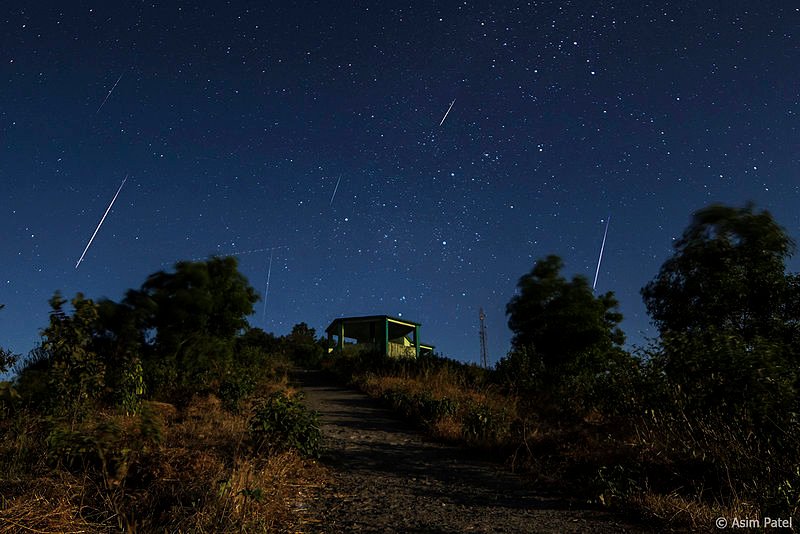Ok, as you might remember my first post for 2018 was about the moon and I also referred to meteor showers, the Quadrantids that will be visible over the night sky of 3rd January (that is tonight). I'll be explaining a bit the meteor shower phenomenon and the distinction between meteors and meteoroids.

(Image from: commons.wikimedia.org - Author, Asim Patel - License)
First things first, meteor - meteoroids - meteorites
My Greek anscestors had the word μετέωρον (me-te-o-ron) to describe phenomena in the sky. This word gave the name to meteors, meteoroids and meteorites. Did you get confused? Well, basically they are the same thing, make-a-wish material (or shooting stars if you like).
They all start as meteoroids
Meteoroids are rocky fragments of comets or asteroids. As they travel through space, they crash into the Earth's atmosphere and start burning through friction. Imagine being hurled into a deep swimming pool at top speed. Your body would get severely burnt, that's what happens to meteoroids when they leave the "empty" space and enter the atmosphere as fast as several hudreds to thousands miles per hour. They bump into the atmospheric molecules and friction damages them really badly, leaving a shiny trail behind them. It's then when a meteoroid becomes...
A meteor
Meteors never get to touch the ground. They are usually small like pebbles and they get totally burnt out before making it to the ground. If, though, some meteoroids are big enough (like really big), they can get through the atmosphere losing a lot of their mass, but a piece of them will eventually make it to the ground and they become what we call...
Meteorites
Meteorites are very big, rocky masses that hit the Earth and leave a crater as a souvenir. One of the biggest impact craters on the planet is the one in Arizona, which is also a famous tourist attraction. It measures 50,000 years on Earth and was created after an impact with an iron-nickel mass as big as 50 meters in diameter. The crash left a crater with a one-kilometer diameter.
Fireballs
Occasionally, some meteors are too bright and are then called fireballs. Their brightness might be such that makes them visible even during day time. Fireballs can be also accompanied by sounds, just like lightning is followed by thunder.
This celestial fire-show takes place 80-110 kilometers above our heads as the Earth gets "attacked" by meteoroids on a daily basis. The debris getting to its surface like dust can weigh up to 44 tons! (The Earth is getting fatter every day 😋) But our planet is not the only one who takes part in this peculiar stone-fight. They hit other celestial bodies of our solar system too.
Meteor showers
Unlike typicals showers, they have nothing to do with water. Meteor showers happen when lots of meteoroids fall on the Earth around the same time. Their names come from the constellation near which the shower can be viewed. Meteor showers follow time patterns, they usually happen annually or whenever a comet's trail of rubble meets the Earth's orbit.
Some of the most well-known showers are the Perseids, the Leonids, the Aquarids and the Orionids (Halley), and the Taurids.

(Image from: commons.wikimedia.org - Author, Ian Norman- License)
The Quadrantids
Whereas the above meteors originate from comets, the Quadrantids are asteroid leftovers from the asteroid 2003 EH1. They were first seen in 1825 and their radiant (the point where they appear to come from) is the Quadrans Muralis (a constellation that no longer exists). They are also named Bootids, from the constellation of Bootes. The constellations are not the points where the shower is visible, but only the seemingly "source" of the meteoroids. The light show is visible across the whole sky.
The Quadrantids show every early January and peak (when the most meteroids fall) for only a few hours, unlike most showers that their peak lasts for a couple of days. If the environmental conditions are perfect, you can see from 60-200 meteroids per hour during peak time. They are also more impressive than other showers, as they usually produce fireballs that last longer and shine brighter than other meteroid streaks.
Who are lucky enough to see them tonight?
If you live in the Northern hemisphere, chances are you'll get to see them, on condition that you're a night owl or just willing to sacrifice your sleep. The Quadrantids are expected to peak at 4 p.m. EST (2100 GMT). So put a warm blanket around your shoulders and get out to enjoy the show!
Here is a guide with meteor showers for the new year provided by earthsky.org
References
starchild.gsfc.nasa.gov
space.com
timeanddate.com
solarsystem.nasa.gov_1
solarsystem.nasa.gov_2

Thank you for stopping by and reading this post. If you want to see more of my stuff, you can go through the links below:
- Trolls Around The Solar System (Part 4 - The Asteroid Belt)
- A New Year, A Full Moon And Belated New Year's Fireworks
- A 2017 Review And A Happy New Year!
- Let's Learn Something Cool - My Red Is Not The Same As Yours
- Diamonds And Rust - A Short Story Of Science Fiction

Until my next post,
Steem on and keep smiling, people!



